Jiujiu Chen
bupt.edu.cn
Molecule Joint Auto-Encoding: Trajectory Pretraining with 2D and 3D Diffusion
Dec 06, 2023Abstract:Recently, artificial intelligence for drug discovery has raised increasing interest in both machine learning and chemistry domains. The fundamental building block for drug discovery is molecule geometry and thus, the molecule's geometrical representation is the main bottleneck to better utilize machine learning techniques for drug discovery. In this work, we propose a pretraining method for molecule joint auto-encoding (MoleculeJAE). MoleculeJAE can learn both the 2D bond (topology) and 3D conformation (geometry) information, and a diffusion process model is applied to mimic the augmented trajectories of such two modalities, based on which, MoleculeJAE will learn the inherent chemical structure in a self-supervised manner. Thus, the pretrained geometrical representation in MoleculeJAE is expected to benefit downstream geometry-related tasks. Empirically, MoleculeJAE proves its effectiveness by reaching state-of-the-art performance on 15 out of 20 tasks by comparing it with 12 competitive baselines.
Deep Joint Source-Channel Coding for Wireless Image Transmission with Semantic Importance
Feb 05, 2023Abstract:The sixth-generation mobile communication system proposes the vision of smart interconnection of everything, which requires accomplishing communication tasks while ensuring the performance of intelligent tasks. A joint source-channel coding method based on semantic importance is proposed, which aims at preserving semantic information during wireless image transmission and thereby boosting the performance of intelligent tasks for images at the receiver. Specifically, we first propose semantic importance weight calculation method, which is based on the gradient of intelligent task's perception results with respect to the features. Then, we design the semantic loss function in the way of using semantic weights to weight the features. Finally, we train the deep joint source-channel coding network using the semantic loss function. Experiment results demonstrate that the proposed method achieves up to 57.7% and 9.1% improvement in terms of intelligent task's performance compared with the source-channel separation coding method and the deep sourcechannel joint coding method without considering semantics at the same compression rate and signal-to-noise ratio, respectively.
Deep Joint Source-Channel Coding Based on Semantics of Pixels
Aug 24, 2022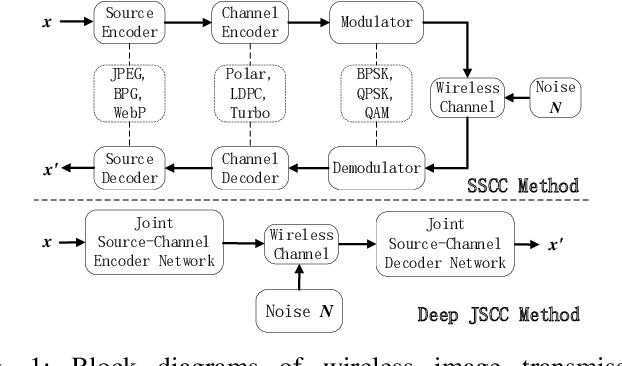

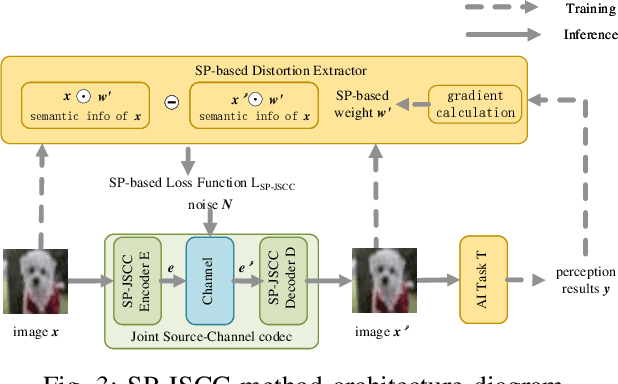

Abstract:The semantic information of the image for intelligent tasks is hidden behind the pixels, and slight changes in the pixels will affect the performance of intelligent tasks. In order to preserve semantic information behind pixels for intelligent tasks during wireless image transmission, we propose a joint source-channel coding method based on semantics of pixels, which can improve the performance of intelligent tasks for images at the receiver by retaining semantic information. Specifically, we first utilize gradients of intelligent task's perception results with respect to pixels to represent the semantic importance of pixels. Then, we extract the semantic distortion, and train the deep joint source-channel coding network with the goal of minimizing semantic distortion rather than pixel's distortion. Experiment results demonstrate that the proposed method improves the performance of the intelligent classification task by 1.38% and 66% compared with the SOTA deep joint source-channel coding method and the traditional separately source-channel coding method at the same transmission ra te and signal-to-noise ratio.
Semantic-assisted image compression
Jan 29, 2022Abstract:Conventional image compression methods typically aim at pixel-level consistency while ignoring the performance of downstream AI tasks.To solve this problem, this paper proposes a Semantic-Assisted Image Compression method (SAIC), which can maintain semantic-level consistency to enable high performance of downstream AI tasks.To this end, we train the compression network using semantic-level loss function. In particular, semantic-level loss is measured using gradient-based semantic weights mechanism (GSW). GSW directly consider downstream AI tasks' perceptual results. Then, this paper proposes a semantic-level distortion evaluation metric to quantify the amount of semantic information retained during the compression process. Experimental results show that the proposed SAIC method can retain more semantic-level information and achieve better performance of downstream AI tasks compared to the traditional deep learning-based method and the advanced perceptual method at the same compression ratio.
Bandwidth and Power Allocation for Task-Oriented SemanticCommunication
Jan 26, 2022Abstract:Deep learning enabled semantic communication has been studied to improve communication efficiency while guaranteeing intelligent task performance. Different from conventional communications systems, the resource allocation in semantic communications no longer just pursues the bit transmission rate, but focuses on how to better compress and transmit semantic to complete subsequent intelligent tasks. This paper aims to appropriately allocate the bandwidth and power for artificial intelligence (AI) task-oriented semantic communication and proposes a joint compressiom ratio and resource allocation (CRRA) algorithm. We first analyze the relationship between the AI task's performance and the semantic information. Then, to optimize the AI task's perfomance under resource constraints, a bandwidth and power allocation problem is formulated. The problem is first separated into two subproblems due to the non-convexity. The first subproblem is a compression ratio optimization problem with a given resource allocation scheme, which is solved by a enumeration algorithm. The second subproblem is to find the optimal resource allocation scheme, which is transformed into a convex problem by successive convex approximation method, and solved by a convex optimization method. The optimal semantic compression ratio and resource allocation scheme are obtained by iteratively solving these two subproblems. Simulation results show that the proposed algorithm can efficiently improve the AI task's performance by up to 30\% comprared with baselines.
Jointly Learning Agent and Lane Information for Multimodal Trajectory Prediction
Nov 26, 2021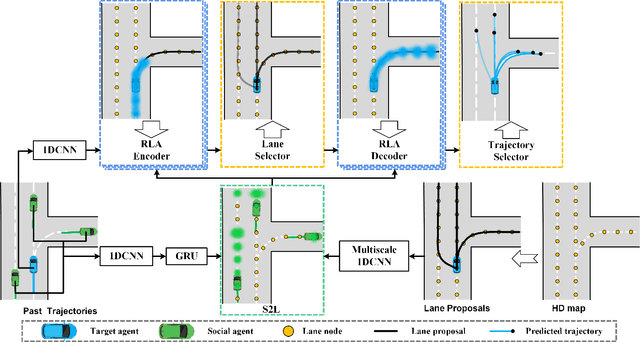
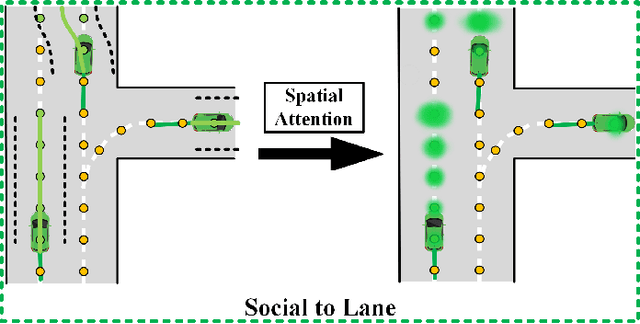
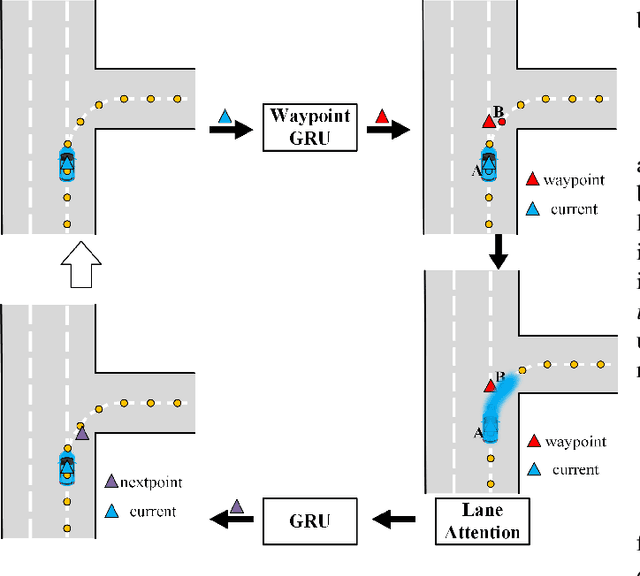
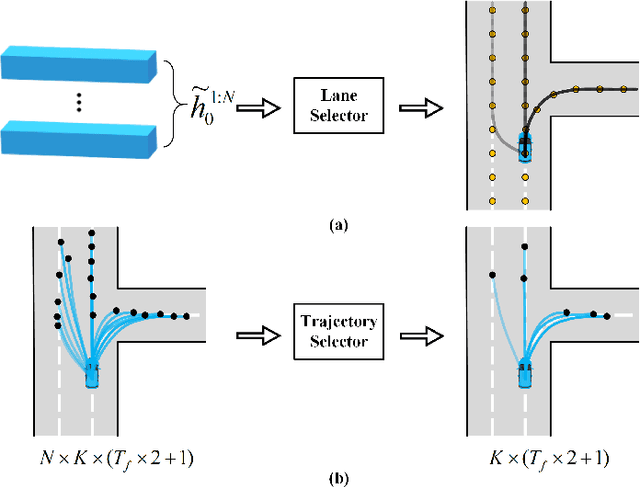
Abstract:Predicting the plausible future trajectories of nearby agents is a core challenge for the safety of Autonomous Vehicles and it mainly depends on two external cues: the dynamic neighbor agents and static scene context. Recent approaches have made great progress in characterizing the two cues separately. However, they ignore the correlation between the two cues and most of them are difficult to achieve map-adaptive prediction. In this paper, we use lane as scene data and propose a staged network that Jointly learning Agent and Lane information for Multimodal Trajectory Prediction (JAL-MTP). JAL-MTP use a Social to Lane (S2L) module to jointly represent the static lane and the dynamic motion of the neighboring agents as instance-level lane, a Recurrent Lane Attention (RLA) mechanism for utilizing the instance-level lanes to predict the map-adaptive future trajectories and two selectors to identify the typical and reasonable trajectories. The experiments conducted on the public Argoverse dataset demonstrate that JAL-MTP significantly outperforms the existing models in both quantitative and qualitative.
Semantic Communications With AI Tasks
Sep 29, 2021
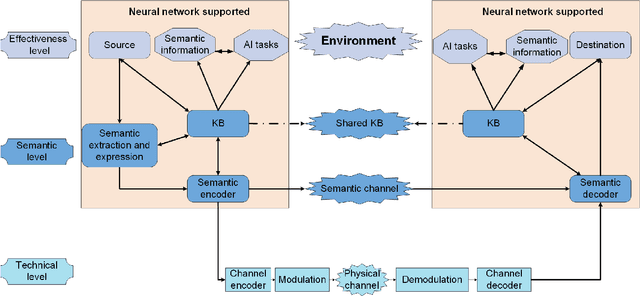
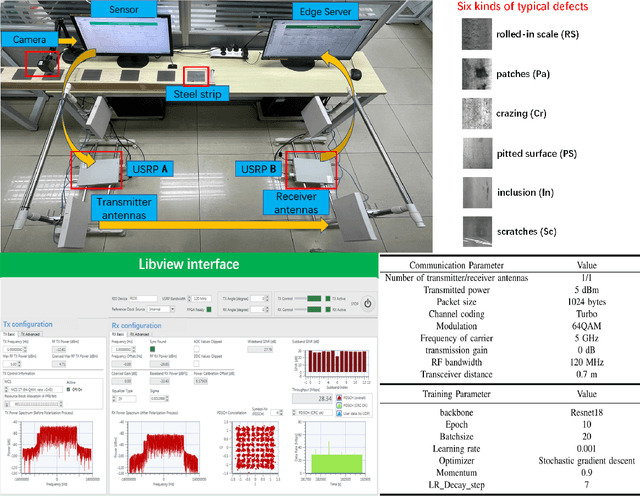
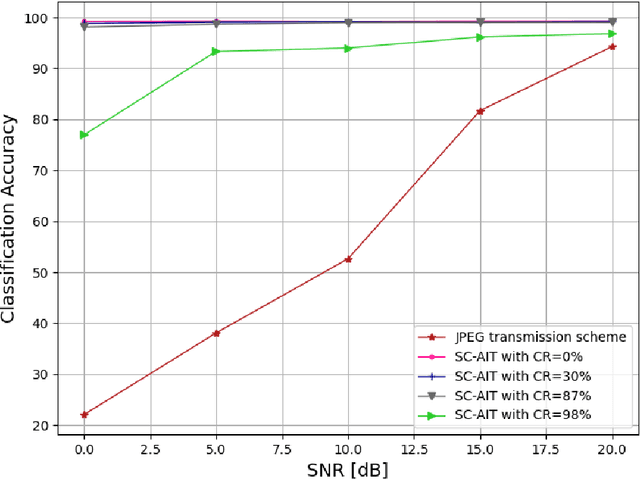
Abstract:A radical paradigm shift of wireless networks from ``connected things'' to ``connected intelligence'' undergoes, which coincides with the Shanno and Weaver's envisions: Communications will transform from the technical level to the semantic level. This article proposes a semantic communication method with artificial intelligence tasks (SC-AIT). First, the architecture of SC-AIT is elaborated. Then, based on the proposed architecture, we implement SC-AIT for a image classifications task. A prototype of SC-AIT is also established for surface defect detection, is conducted. Experimental results show that SC-AIT has much lower bandwidth requirements, and can achieve more than $40\%$ classification accuracy gains compared with the communications at the technical level. Future trends and key challenges for semantic communications are also identified.
 Add to Chrome
Add to Chrome Add to Firefox
Add to Firefox Add to Edge
Add to Edge